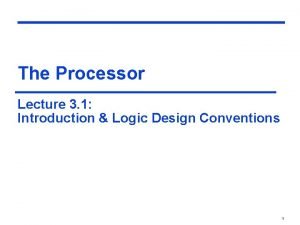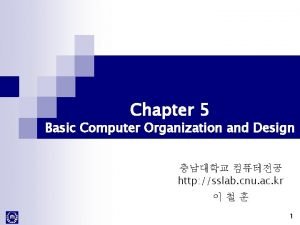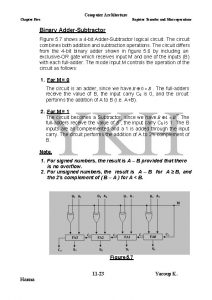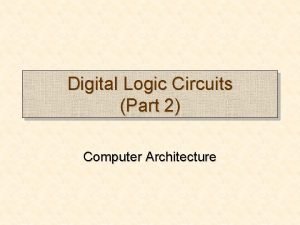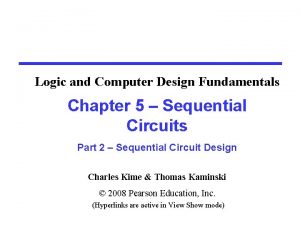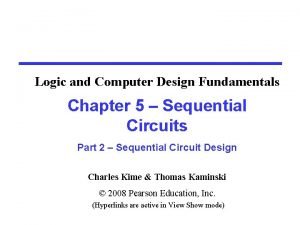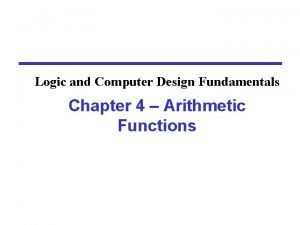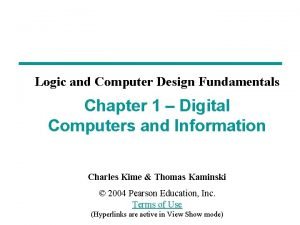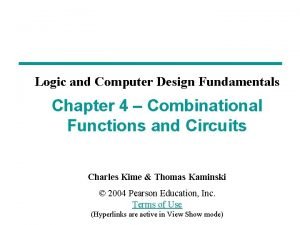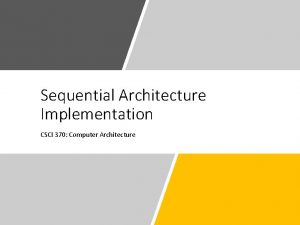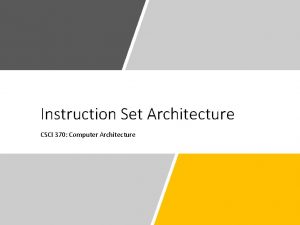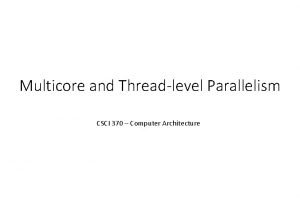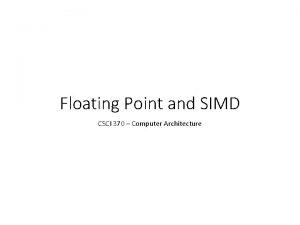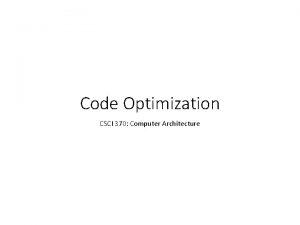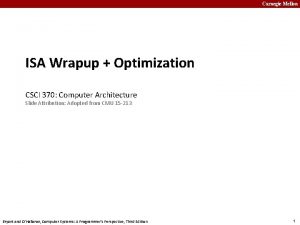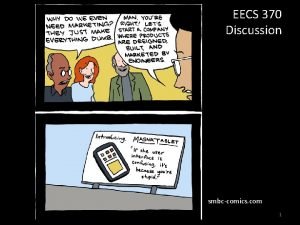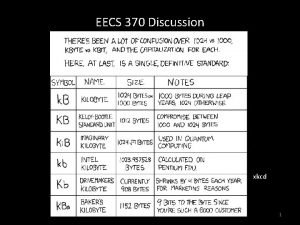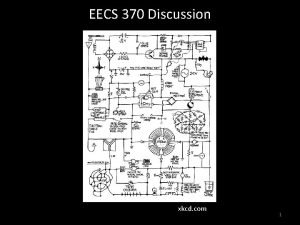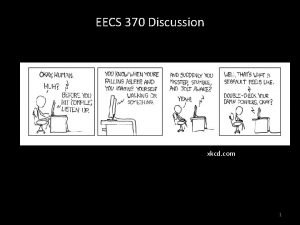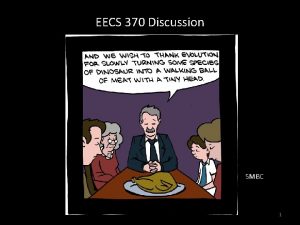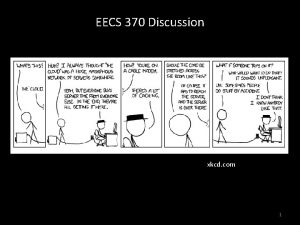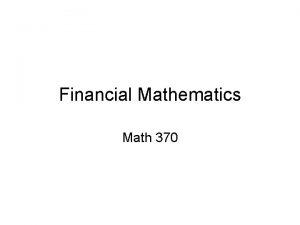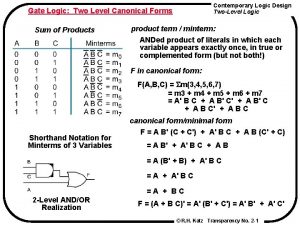Logic Design CSCI 370 Computer Architecture Overview of



















- Slides: 19

Logic Design CSCI 370: Computer Architecture

Overview of Logic Design • Fundamental Hardware Requirements • Communication • How to get values from one place to another • Computation • Storage • Bits are Our Friends • Everything expressed in terms of values 0 and 1 • Communication • Low or high voltage on wire • Computation • Compute Boolean functions • Storage • Store bits of information

Digital Signals 0 1 0 Voltage Time • Use voltage thresholds to extract discrete values from continuous signal • Simplest version: 1 -bit signal • Either high range (1) or low range (0) • With guard range between them • Not strongly affected by noise or low quality circuit elements • Can make circuits simple, small, and fast

Computing with Logic Gates • Outputs are Boolean functions of inputs • Respond continuously to changes in inputs • With some, small delay Rising Delay Voltage Falling Delay a && b b a Time

Combinational Circuits Acyclic Network Primary Inputs Primary Outputs • Acyclic Network of Logic Gates • Continously responds to changes on primary inputs • Primary outputs become (after some delay) Boolean functions of primary inputs

Bit Equality a Bit equal HCL Expression eq bool eq = (a&&b)||(!a&&!b) b • Generate 1 if a and b are equal • Hardware Control Language (HCL) • Very simple hardware description language • Boolean operations have syntax similar to C logical operations • We’ll use it to describe control logic for processors

Word Equality b 63 a 63 b 62 a 62 Bit equal Word-Level Representation eq 63 B eq 62 A HCL Representation Eq b 1 a 1 b 0 a 0 = Eq Bit equal bool Eq = (A == B) eq 1 eq 0 • 64 -bit word size • HCL representation • Equality operation • Generates Boolean value

Bit-Level Multiplexor s Bit MUX b a • Control signal s • Data signals a and b • Output a when s=1, b when s=0 HCL Expression bool out = (s&&a)||(!s&&b) out

Word Multiplexor Word-Level Representation s s b 63 B out 63 a 63 b 62 A MUX Out HCL Representation out 62 a 62 int Out = [ s : A; 1 : B; ]; • Select input word A or B depending on control signal s • HCL representation b 0 a 0 out 0 • Case expression • Series of test : value pairs • Output value for first successful test

HCL Word-Level Examples Minimum of 3 Words C B A MIN 3 Min 3 • Find minimum of three input int Min 3 = [ words A < B && A < C : A; • HCL case expression B < A && B < C : B; • Final case guarantees match 1 : C; ]; 4 -Way Multiplexor s 1 s 0 D 1 D 2 D 3 MUX 4 Out 4 int Out 4 = [ !s 1&&!s 0: D 0; !s 1 : D 1; !s 0 : D 2; 1 : D 3; ]; n Select one of 4 inputs based on two control bits n HCL case expression Simplify tests by assuming sequential matching n

Arithmetic Logic Unit 0 Y X A B A L U 1 Y A X+Y OF ZF CF X B 2 Y A L U A X-Y OF ZF CF X Y A L U B • Combinational logic • Continuously responding to inputs • Control signal selects function computed • Corresponding to 4 arithmetic/logical operations in Y 86 -64 • Also computes values for condition codes 3 A X&Y OF ZF CF X B A L U X^Y OF ZF CF

Registers Structure i 7 i 6 i 5 i 4 i 3 i 2 i 1 i 0 D C Q+ o 7 D C Q+ o 6 D C Q+ o 5 D C Q+ o 4 D C Q+ o 3 D C Q+ o 2 D C Q+ o 1 D C Q+ o 0 Clock • Stores word of data • Different from program registers seen in assembly code • Collection of edge-triggered latches • Loads input on rising edge of clock I O Clock

Register Operation State = x Input = y Output = x x State = y Rising clock • Stores data bits • For most of time acts as barrier between input and output • As clock rises, loads input Output = y y

State Machine Example Comb. Logic 0 A L U In • Accumulator circuit • Load or accumulate on each cycle 0 Out MUX 1 Load Clock Load In x 0 Out x 1 x 0 x 2 x 0+x 1 x 3 x 0+x 1+x 2 x 3 x 4 x 5 x 3+x 4+x 5

Random-Access Memory val. A src. A Read ports val. B src. B A Register file val. W W B • Stores multiple words of memory • Address input specifies which word to read or write • Register file • Holds values of program registers • %rax, %rsp, etc. • Register identifier serves as address • ID 15 (0 x. F) implies no read or write performed • Multiple Ports • Can read and/or write multiple words in one cycle • Each has separate address and data input/output Clock dst. W Write port

Register File Timing • Reading val. A src. A x val. B src. B A • Like combinational logic • Output data generated based on input address 2 x Register file • After some delay • Writing B • Like register • Update only as clock rises 2 2 x Register file val. W W Clock dst. W y 2 Rising clock 2 y Register file val. W W Clock dst. W

Hardware Control Language • Very simple hardware description language • Can only express limited aspects of hardware operation • Parts we want to explore and modify • Data Types • bool: Boolean • a, b, c, … • int: words • A, B, C, … • Does not specify word size---bytes, 64 -bit words, … • Statements • bool a = bool-expr ; • int A = int-expr ;

HCL Operations • Classify by type of value returned • Boolean Expressions • Logic Operations • a && b, a || b, !a • Word Comparisons • A == B, A != B, A <= B, A > B • Set Membership • A in { B, C, D } • Same as A == B || A == C || A == D • Word Expressions • Case expressions • [ a : A; b : B; c : C ] • Evaluate test expressions a, b, c, … in sequence • Return word expression A, B, C, … for first successful test

Summary • Computation • Performed by combinational logic • Computes Boolean functions • Continuously reacts to input changes • Storage • Registers • Hold single words • Loaded as clock rises • Random-access memories • • Hold multiple words Possible multiple read or write ports Read word when address input changes Write word as clock rises
 Logic design conventions in computer architecture
Logic design conventions in computer architecture Design of accumulator logic in computer architecture
Design of accumulator logic in computer architecture Simple computer design
Simple computer design Logic microoperations in computer architecture
Logic microoperations in computer architecture Digital logic and computer architecture
Digital logic and computer architecture Logic based testing in software testing
Logic based testing in software testing Jk flip flop
Jk flip flop Fundamentals of logical computing formulation
Fundamentals of logical computing formulation Logic and computer design fundamentals
Logic and computer design fundamentals Logic and computer design fundamentals
Logic and computer design fundamentals Logic & computer design fundamentals
Logic & computer design fundamentals Bus architecture in computer organization
Bus architecture in computer organization Computer organization and computer architecture difference
Computer organization and computer architecture difference First order logic vs propositional logic
First order logic vs propositional logic First order logic vs propositional logic
First order logic vs propositional logic First order logic vs propositional logic
First order logic vs propositional logic Combinational vs sequential logic
Combinational vs sequential logic Tw
Tw Combinational logic sequential logic 차이
Combinational logic sequential logic 차이 Majority circuit
Majority circuit
